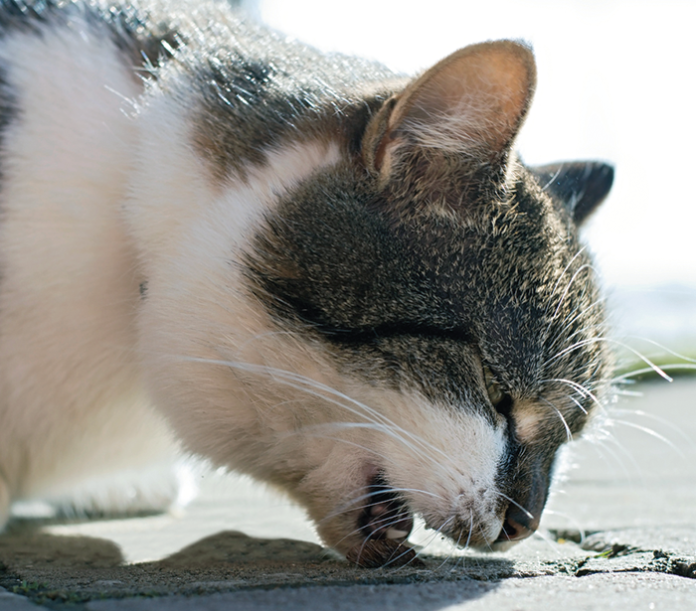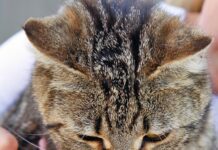Hairballs are, unfortunately, a normal part of being a cat. As your cat grooms herself, the rough barbs on her tongue catch the hair and pull out loose, dead strands. Some of these hairs are then swallowed.
Unfortunately for your cat, the primary structure of hair is the protein keratin, which cannot be digested. Hair that moves through the digestive tract will remain intact and hopefully eventually exit in the stool. Some hair, though, can remain in the stomach and gradually clump together with other hairs. This damp clump of swallowed hair is what we refer to as a hairball.
Hairballs are usually vomited up without incident. According to the Cornell Feline Health Center, “Regurgitated hairballs are variable in size; though usually about an inch long, they can be as long as five inches and an inch thick. The color is mainly that of the cat’s coat, darkened by the color of the animal’s food and various gastric secretions, such as green bile. The ejected matter will typically have an unpleasant odor.”
Hairballs are often mistaken for feces at first glance because they become squished and elongated as they pass through the cat’s esophagus, plus they smell a bit gross. Cats will often make a terrible hacking/gurgling noise that quickly subsides once the stowaway hairs have been expelled. This can happen every week or two and is nothing to be concerned about if your cat is otherwise happy and healthy.
When to Be Concerned
You should seek veterinary attention if your cat exhibits:
- Lethargy
- Inappetence
- Repeated hacking, coughing, or gagging
- Unproductive retching or vomiting (repeatedly trying to vomit but nothing comes up)
- Constipation
- Diarrhea
- Distended abdomen
- Excessive grooming (can indicate stress or skin issues)
While somewhat nonspecific, these signs can indicate potential concerns that may or may not be related to a hairball. Because of this, your veterinarian will need to narrow down the cause. He or she will start with a physical exam and likely do bloodwork to make sure there is no systemic disease process involved. Radiographs may be done to check for a gastrointestinal obstruction or for asthma, the latter especially if the cat is coughing/gagging.
Obstruction
If a hairball gets too big, it can cause problems for your cat. Hairballs that are too large to exit the stomach through either the esophagus or intestines are trapped and continue to grow larger until they either start impacting the cat’s ability to eat or cause a blockage. Hairballs can also get stuck in the intestines. Thankfully, these obstructions are rare, but they are serious when they occur and require prompt treatment.
Treatment of obstructions will depend on the location and size of the blockage. For smaller obstructions, especially if the cat is otherwise in reasonably good health, the veterinarian will likely give laxatives to encourage the hairball to pass naturally. Your cat may also be given fluids to improve hydration. For more severe obstructions, surgery may be needed.
Hairball Products
A variety of commercial products claim to prevent hairballs. Many of these are petroleum-based laxatives that grease up your cat’s digestive tract to keep everything moving smoothly. We strongly recommend consulting your veterinarian before starting one of these products to ensure that the product is safe and effective and that you are giving your cat the correct dosage. Some cats may only need a laxative once in a while, while others with chronic hairball or constipation issues may be kept on them long term.
What You Can Do
Identify risk factors. Older cats and longhaired cats are most prone to hairballs; however, for cats of all ages and hair types, shedding season increases the likelihood of hairballs.
Groom regularly. Brushing removes a lot of loose, dead hair. Even just a few minutes every day can help, with more thorough groomings during spring shedding season. If your cat hates to be brushed or her coat is too difficult to maintain, a shave-down by a groomer or your veterinarian a couple times a year can help.
Promote hydration. Staying hydrated will help keep your cat’s digestive tract running efficiently, including getting any ingested hair out of the body. Pet water fountains can help to encourage cats to drink more, and canned diets contain more moisture.
Provide plenty of fiber. Fiber bulks up stool, making it easier to pass and helping keep the colon healthy. A commercial or nutritionist-formulated balanced diet should provide enough fiber for your cat’s needs, but some cats benefit from additional fiber. Cat grass can be a fun source of fiber for your cat (see “Catnip Crazy,” July 2019, at catwatchnewsletter.com) or you can add a little plain canned pumpkin or psyllium fiber to her food. Hairball formula cat foods have high fiber levels. Consult with your veterinarian before supplementing fiber or switching to a hairball formula to make sure that the changes are appropriate for your cat.




